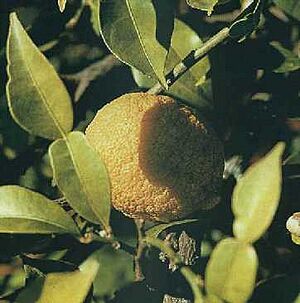Cold-hardy citrus facts for kids
Imagine growing oranges or lemons even in chilly places! Cold-hardy citrus are special types of citrus plants. They can handle much colder weather than regular citrus. This means they can grow in areas far from warm, sunny regions. These plants can usually survive winter temperatures below -5 to -10 degrees Celsius (23 to 14 degrees Fahrenheit). Some are natural citrus types, like the Satsuma mandarin or kumquat. Others are "hybrids," meaning they are a mix of different citrus plants, like the citrange. All citrus fruits can be eaten. However, some cold-hardy types might taste bitter if eaten fresh. But don't worry! Even the bitter ones can be cooked. They are often used to make delicious marmalade.
Types of Cold-Hardy Citrus
There are many kinds of citrus that can handle cold. Some are natural types, and others are special mixes. Here's a look at some of them.
Natural Cold-Hardy Citrus
These are citrus types that naturally handle cold weather well. They are listed from the most cold-hardy to the least.
| Name | Scientific Name | Cold Hardiness | Can You Eat It? | Fun Facts |
|---|---|---|---|---|
| Trifoliate orange | Citrus trifoliata | Can handle -30°C (-22°F) | Not tasty fresh | Often used as a base plant for other citrus trees. It can easily mix with other citrus. |
| Ichang papeda | Citrus cavaleriei | Can handle -18°C (0°F) | Not tasty fresh | This plant is a parent to many other citrus types, like yuzu and sudachi. |
| Jiouyuezao mandarin | Citrus reticulata 'Jiouyuezao' | Can handle -13°C (9°F) | Yes, it's edible | People have grown this type in China for a very long time. |
| Changsha mandarin | Citrus reticulata 'Changsha' | Can handle -11°C (12°F) | Yes, but it has many seeds | This mandarin has also been grown in China for ages. |
| Kumquat | Citrus japonica | Can handle -10°C (14°F) | Yes, it's edible | You can eat the whole fruit, skin and all! The skin is sweet, and the inside is sour. |
| Desert lime | Citrus glauca | Can handle -10°C (14°F) | Yes, it's edible and used in cooking | The whole fruit can be eaten. |
| Satsuma | Citrus reticulata 'Unshiu' | Can handle -5°C (23°F) | Yes, it's very good | This popular fruit has been grown in China for a long time. |
Cold-Hardy Citrus Hybrids
These are special citrus plants created by mixing two different types of citrus. They are also listed from the most cold-hardy to the least.
| Name | Scientific Mix | Cold Hardiness | Can You Eat It? | Fun Facts |
|---|---|---|---|---|
| Citrandarin | Citrus reticulata × Citrus trifoliata | Can handle -18°C (0°F) | Semi-edible (okay to eat, but maybe not fresh) | The 'Changsha' citrandarin is known as the toughest citrus hybrid. |
| Citrange | Citrus × sinensis × Citrus trifoliata | Can handle -18°C (0°F) | Semi-edible | 'Rusk' is thought to be the best-tasting citrange. |
| Citrangequat | Citrus japonica × Citrange | Can handle -15°C (5°F) | Yes, it's edible | 'Thomasville' is considered the tastiest citrangequat. |
| Citrumelo | Citrus × paradisi × Citrus trifoliata | Can handle -15°C (5°F) | Semi-edible | 'Dunstan' is known as the best-tasting citrumelo. |
| Kabosu | Citrus cavaleriei × Citrus x aurantium | Can handle -12°C (10°F) | Yes, it's edible and used in cooking | This fruit has been grown in Japan for a long time. |
| Shuangjuan (Ichang lemon) | Citrus cavaleriei × Citrus maxima | Can handle -12°C (10°F) | Yes, it's edible and used in cooking | This fruit has been grown in China for a long time. |
| Yuzu | Citrus cavaleriei × Citrus reticulata | Can handle -12°C (10°F) | Yes, it's edible and used in cooking | Very popular in Japan, where many types have been grown. |
| Sudachi | Citrus x junos × Citrus leiocarpa/Citrus reticulata var. 'tachibana' | Can handle -12°C (10°F) | Yes, it's edible and used in cooking | This fruit has been grown in Japan for a long time. |
| Orangequat | Citrus sinensis × Citrus japonica | Can handle -9°C (16°F) | Yes, it's edible | 'Nippon' is a favorite for its taste and ability to handle cold. |
| Rangpur lime | Citrus medica × Citrus reticulata | Can handle -9°C (16°F) | Yes, it's edible and used in cooking | This fruit has been grown in South Asia for a long time. |
| Calamondin | Citrus reticulata × Citrus japonica | Can handle -8°C (18°F) | Yes, it's edible and used in cooking | This fruit has been grown in the Philippines for a long time. |
| Chinotto | Citrus x aurantium var. 'myrtifolia' | Can handle -8°C (18°F) | Yes, it's edible, but too bitter to eat raw | This fruit has been grown in Southern Italy, Malta, and Libya for a long time. |


